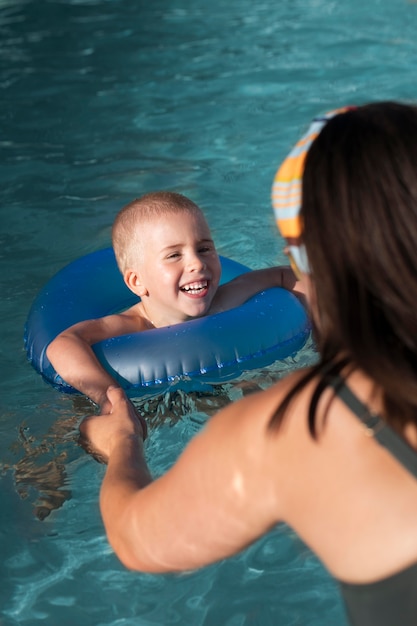
Swimming is a fantastic activity for toddlers. It’s not just fun, but it also keeps them active. However, safety should always be the top priority. Here are some simple rules to ensure your little one’s safety:
1. **Never leave your toddler unsupervised in the pool.**
2. **Ensure they take regular breaks to prevent exhaustion.**
3. **Keep them entertained with plenty of pool toys.**
By following these rules, you can make sure your toddler’s swimming experience is both safe and enjoyable.
Now, let’s dive deeper into the world of toddler swimming.
**When should your child start swimming?**
Typically, children start swimming lessons from the third month of life for baby swimming, and from the second year of life for toddler swimming. The main goal at this stage is to get them comfortable with water and to start learning basic swimming movements.
Swimming instructors often recommend the classic seahorse course for children aged five and above. Remember, every child is different. Some may learn quickly, while others may take more time. Some might be fearless, while others might be more cautious. A good instructor will adapt the exercises to suit each child’s needs.
Parents should also be patient and understanding. If your child is scared or needs more practice, it’s okay to take a break. The important thing is to keep trying. Even in a structured swimming course, it might take more than ten hours for a child to feel confident in the water.
**Understanding your child’s relationship with water**
Children react to water in different ways. Some might be natural water lovers, diving and trying out their first swimming strokes at the age of two or three. Others might be more cautious, preferring to play on the shallow end or float on their backs with the support of a parent.
Regardless of whether your toddler loves water or is a bit scared, the goal is to help them truly experience and enjoy the water. Patience and practice are key.
**Safety first**
No matter how well your child can swim or how safe you think the pool is, accidents can happen in an instant. So, always keep a close eye on your toddler, especially during their first swimming lessons.
**Learning about water safety**
Keeping kids safe is a full-time job, especially when it comes to water safety. That’s why it’s a great idea to enroll your child in swimming lessons with an experienced instructor.
A good instructor will teach your child not just how to swim, but also how to stay safe in and around water. They’ll cover important topics like what to do if they get caught in a rip current, how to identify a dangerous wave, and how to properly wear a life jacket.
Remember, drowning can happen silently, without any calls for help. That’s why it’s crucial to always go to a guarded bathing area for your toddler’s first swimming lessons. In case of an emergency, help can arrive quickly.
**A word of caution about swimming aids**
While armbands can help with buoyancy, they’re not a substitute for swimming skills or life jackets. In fact, they can sometimes do more harm than good. For example, a baby’s head can quickly go underwater. So, it’s best to avoid swimming aids when your child is learning to swim. Instead, always stay within arm’s reach of your child so you can help them immediately if they run into any trouble.
Professional swimming lessons can also help instill a healthy respect for water in your child. So, consider enrolling your child in swimming lessons with a qualified instructor. It’s a great way to ensure your child’s safety while also having a lot of fun!






